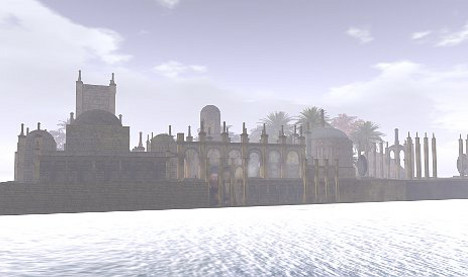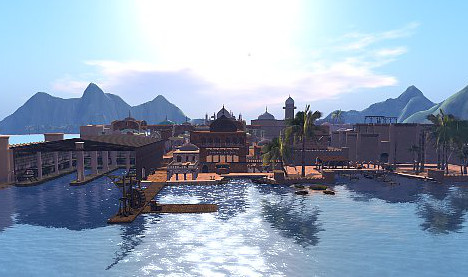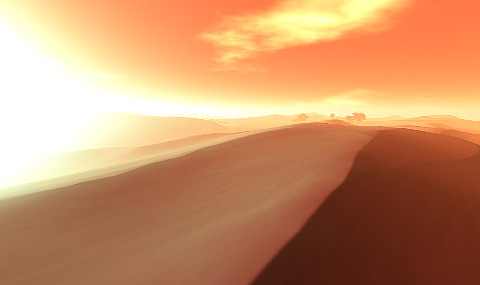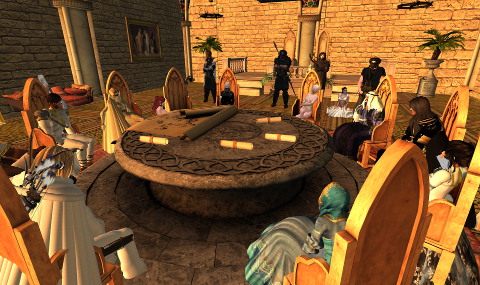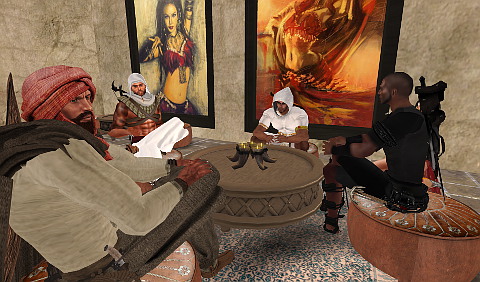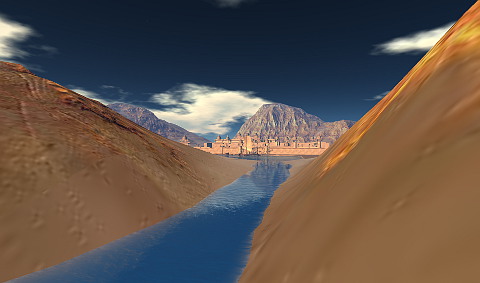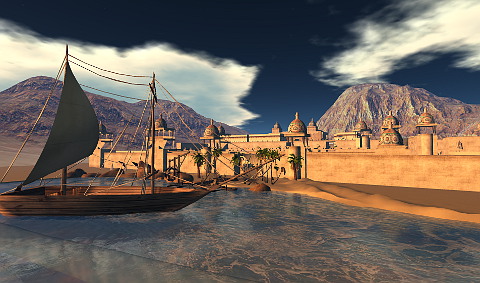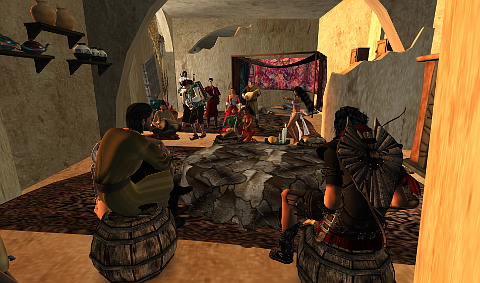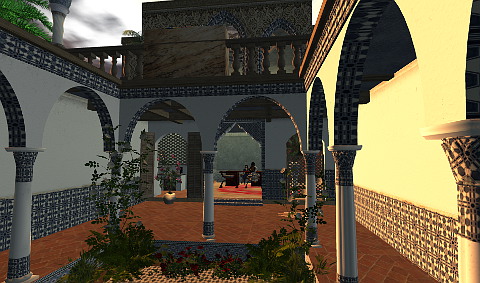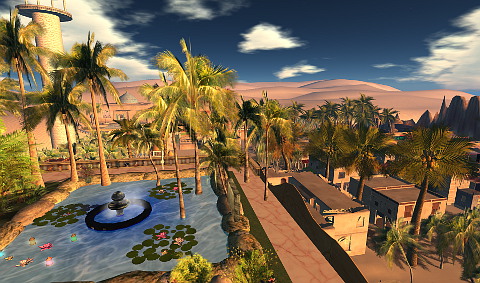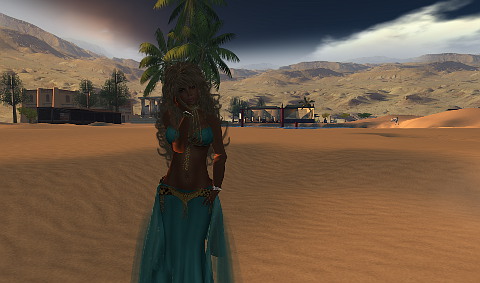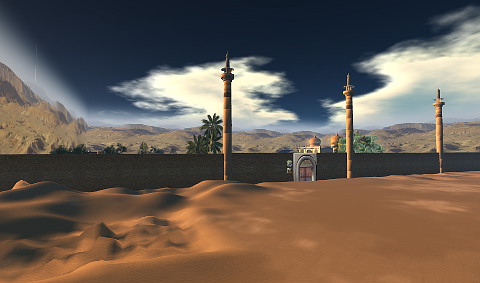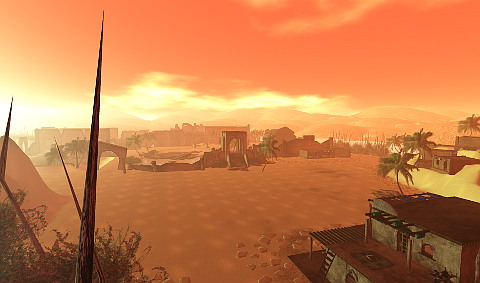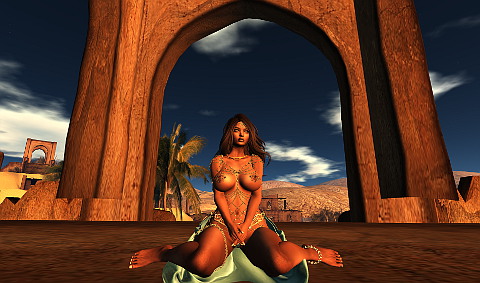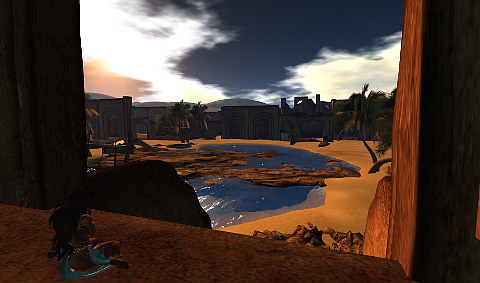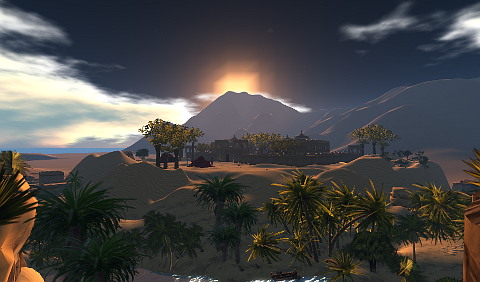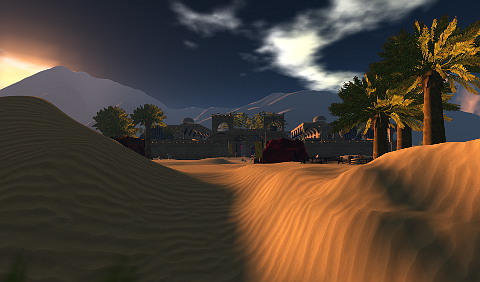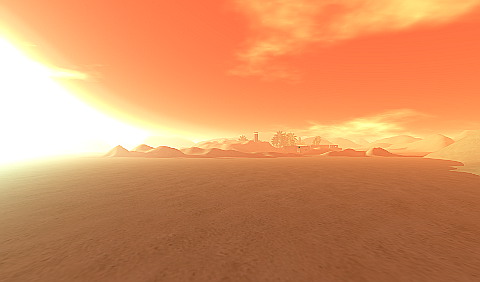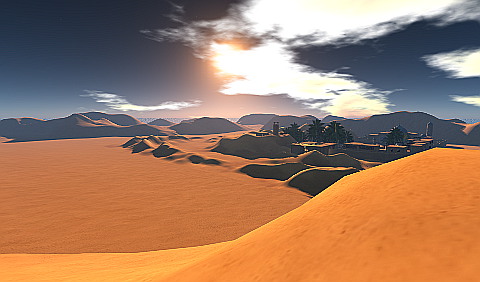Archive for the ‘Tahari’ Category
Oasis of Klima is back!
Saturday, September 24th, 2016A caravan of merchants of the Southern Trade Alliance has made the way to the Oasis of Klima again. The path was lost for a long time.
In the distance, below, perhaps five pasangs away, in the hot, concave, white salt bleakness, like a vast, white, shallow bowl, pasangs wide, there were compounds, low, white buildings of mud brick, plastered. There were many of them. They were hard to see in the distance, in the light, but I could make them out.
«Klima, »said Hamid.
Most salt at Klima is white, but certain of the mines deliver red salt, red from ferrous oxide in its composition, which is called the Red Salt of Kasra, after its port of embarkation, at the juncture of the Upper and Lower Fayeen.
“For twenty days had we marched. Some thought it a hundred. Many had lost count. More than two hundred and fifty men had been originally in the salt chain. I did not know how many now trekked with the march. The chain was now much heavier than it had been, for it, even with several sections removed, was carried by far fewer men. To be a salt slave, it is said, one must be strong. Only the strong, it is said, reach Klima.”
Second Salt Decree Declared!
Tuesday, September 6th, 2016DECLARATION OF THE TRUE SOUTHERN TRADE ALLIANCE
Declared and confirmed by the high assembly of STA members
Second day of the fourth hand of the sixth month of the year 10167 Contasta Ar
To: All Gorean Merchants
Concerning: Tahari Salt decree by the SOUTHERN TRADE ALLIANCE
I.
In order to guarantee the fine quality of Tahari Salt only the following oases and cities of the Tahari are allowed to have their salt trademarked as Tahari Salt :
1. City of Tor
2. Oasis of Sand Sleen
3. Teehra
4. Oasis of Two Scimitars (Oases der Zwei Scimitare, German )
II.
All merchants who want to trade with red or yellow salt of the Tahari need to visit the City of Tor or the Oasis of Sand Sleen or Teehra to get it. Red and Yellow salt without a valid receipt from Tor or Sand Sleen or Teehra will be treated as smugglers. The STA declares the trade with red and yellow salt illegal except from certified merchants from Tor or Sand Sleen or Teehra or the Oase der zwei Scimitare.
III.
The true SOUTHERN TRADE ALLIANCE will control the salt trade of all Tahari Salt. Only members of the SOUTHERN TRADE ALLIANCE (STA) are allowed to sell the salt of the above mentioned four places out of the Tahari and each sale should include the SOUTHERN TRADE ALLIANCE seal. Merchants of all gorean cities are hereby informed that Tahari Salt without the seal is considered as smuggling, with all due consequences as a result.
Only salt bags of red and yellow salt which have a valid certifications from Teehra (or former Kasra/Fayeen), Sand Sleen or Tor are valid.
IV.
The true yellow and red salt delivered by STA merchants is only for your own consumption. You are NOT allow to resell it.
This decree will be effective as today.
May you always have water, may your water bags never be empty!
signed by the SOUTHERN TRADE ALLIANCE
Sealed by:
Doc Grun, Vizier of the Taharian city of Tor, former High Pasha of the Oasis of Nine Wells
Jabari Adheem Ibn Yusuf (hideogarvan) , Pasha of Teehra
Imani bint Saran (zayla.whitesong), representing ibn Saran, salt Ubar of the Kasbah
Angel Firethorn, High Pasha of the Oasis of Sand Sleen
Ulric Merlin, Head merchant Oase der Zwei Scimitare
Witnessed: Rarius Yuroki (Rarius Yuroki), STA ambassador, head merchant of Ianda
Back from the Sardar!
Thursday, September 1st, 2016Picture: Ianda head merchant Rarius Yuroki and Ianda deputy administrator Marcus Attilius Flamma talking to the authorities of Teehra.
Many free persons on Gor seldom travel more than a few pasangs from their village or the walls of their city. An important exception to this is the pilgrimage to the Sardar, which every Gorean, male and female, is expected to undertake at least once in his life. The journey, of course, from many points on Gor to the Sardar is, at least in certain parts, dangerous.
Sherman Easterwood traveled to Sardar for months. He returned back safe and sound and resumed his position as Administrator of Ianda.
Marcus Attilius Flamma stepped back and will be deputy administrator of Ianda on the Isle of Landa.
Teehra, Fayeen river
Saturday, August 6th, 2016Approaching Teehra, near the Fayeen river and the ruins of old Kasra.
The Tahari region is located southeast of Ar, below the eastern foothills of the Voltai Mountians. This area is shaped like an enormous, lengthy trapezoid with eastward leaning sides. At the northwest corner of this region is the opulent city of Tor. Further west of Tor, on the Lower Fayeen River, is the city of Kasra. The desert area in the middle is known as the Wastes or the Emptiness. This area is hundreds, or even thousands, of pasangs wide. It is mostly rocky and hilly except for the dune country area. A hot wind blows nearly constantly there and water is very scarce. There are some oases that are fed from underground rivers, tributaries that flow from the Voltai.
Oase der Zwei Scimitare
Saturday, August 6th, 2016Oasis of Two Scimitars (german Oase der zwei Scimitare), the crowded tavern, musicians playing.
Little is mentioned about this oasis. We do know that it is an isolated and obscure oasis, far from the established trade routes, that is under the control of the Bakahs who were once a vassal tribe of the Kavars.
City of Tor and its outskirts
Saturday, August 6th, 2016Negotiating with Doc Grun, Vizier, former High Pasha of the Oasis of Nine Wells, in the City of Tor.
Much of the city, of course, was organized to support the caravan trade. There were many walled, guarded warehouses, requiring their staffs of scribes and guards, and, in hundreds of hovels, lived kaiila tenders, drovers, and such, who would, at the caravan tables, when their moneys had been exhausted, apply, if accepted, making their mark on the roster, once more for a post with some new caravan. Guards for these caravans, incidentally, were usually known by, and retained by, caravan merchants between caravans. They were known men. Tenders and drovers, on the whole, came and went. Elaborate random selection devices, utilizing coins and sticks, and formulas, were sometimes used by merchants to assure that applying tenders and drovers were selected, if they were not known, by chance. Tenders and drovers were assured that this was to insure fairness. Actually, of course, as was well known, this was a precaution against the danger of hiring, en bloc, unwittingly, an organized group of men, who might, prior to their hiring, have formed a plan to slay the guards and merchants and make off with the caravan. Tenders and drovers, however, like men generally, were an honest sort.
Tor, rather similarly, (to the oasis) though few crops were grown within its walls, was built high, about its water, several wells in the deepest area in the city. The architecture of Tor, in concentric circles, broken by numerous, narrow, crooked streets, was a function of the radius from its wells. An advantage of this municipal organization, of course, though it is scarcely a matter of intentional design, is that the water is in the most protected portion of the city, its center.
These buildings, on the outside smooth and bleak, save for occasional narrow windows, high, not wide enough to admit a body, abut directly on the streets, making the streets like deep, walled alleys. In the center of the street is a gutter. It seldom rains in Tor, but the gutter serves to collect waste, which is often thrown into it, through open doors, by slaves. Within these walls, however, so pressing upon the street, I knew there were often gardens, walled, well-watered, beautiful, and cool, dark rooms, shielded from the heat and sun, many with superb appointments.
The buildings of Tor are of mud brick, covered with colored, often flaking, plasters. But now, in the sun, and the dust, raised by the people in the streets, everything seemed drained of color.
Tor was, as Gorean cities went, rich, trading city. It was headquarters for thousands of caravan merchants. In it, too, were housed many craftsmen, practicing their industries, carvers, varnishers, table makers, gem cutters, jewelers, carders, dyers of cloth, weavers of rugs, tanners, makers of slippers, toolers of leather, potters, glaziers, makers of cups and kettles, weapon smiths, and many others. Much of the city, of course, was organized to support the caravan trade.
Tor, lying at the northwest corner of the Tahari, is the principal supplying point for the scattered oasis communities of that dry vastness, almost a continent of rock, and heat, and wind and sand.
(from “Tribesmen of Gor”)
Oasis of Sand Sleen, revisited
Saturday, August 6th, 2016The Kavar Oasis of Sand Sleen and the First Girl Devilssabre.
The Kavar is the other major tribe of the Tahari and is often at odds with the Aretai. Their vassal tribes are the Ta’Kara, Bakahs, Cha,r and Kashani. Their war cry is ‘Kavars Supreme!’. Their mark is a blue scimitar facing outward from the body on the right forearm. Weapons include the Weapons sleeve dagger and scimitar.
The major tribes were ruled by Pashas. The Pasha often resided in a Kasbah, the fortress.
Men also wear the kaffiyeh and the agal. The kaffiyeh is a squarish scarf, folded over into a triangle, and placed over the head. Two points of it are placed at the side of the shoulders. One is placed in the back to protect the back of the neck. It is bound to the head by the agal, several loops of cord. The cording indicates a person’s tribe and district in the Tahari region. Some men, generally in the cities, may wear a head scarf, a wrapped turban of rep cloth. This protects the head from the sun and does not permit sweat to escape. Among lower-caste men, it can also provide a soft cushion for boxes and other burdens. You simply steady the burden with your right hand. In doors, men commonly wear soft, heel-less slippers with extended, curling toes.
Slave girls in the Tahari often wear chalwars. These are baggy pants of diaphanous silk, gathered in closely at the ankles. They are worn low on the hips, several inches below the belly button. They are similar to the harem trousers of the middle east region of Earth. They may also wear a silk vest with the chalwars.
Mirage Oasis
Monday, July 11th, 2016Mirage Oasis, Tahari Desert
Ada Kaleh – Tashid Oasis – Tahari Desert
Saturday, May 14th, 2016Ada Kaleh – Karawanserei, Oase, Clan der Tashid
In the Glowing Heat of the Tahari
Friday, April 8th, 2016THE RETURN OF THE OASIS!
by AdriaRickman Resident (Adria), High scribe of Ianda on the Isle of landa
Word has returned of massive sandstorms that decimated the cities of Oasis of Sand Sleen and Oasis of Nine Wells! They lay in ruins, it’s said, the wells all dried of water, ruins found on the outskirts of the cities, the caravans turned back to the City of Tor and Oasis of Two Scimitars.
On the return road they heard many rumours, one being a massive Kurii ship had crashed, destroying everything in its wake and one other that the Bazi plague had hit and the citizens of the two Oasis had sealed off the cities to stop it spreading.
But not to be deterred they found cartographers, mapmakers and other merchants and made plans to start again for the Oasis cities, and good news! They did indeed find a new route!
The merchants of the southern trade alliance discovered the new route, they blazed new trails and fought through new lands to find they Oasis again. When they arrived, cautiously looking round, they found no evidence of Kurii, or Bazi plague! The people told of a huge sandstorm, and although some lives were lost and buildings damaged, they still had water and the wells were unaffected.
They are in the process of rebuilding now and so trade remains with an additional route.
(The Oasis of Sand Sleen is co-founder of the Southern Trade Alliance]
